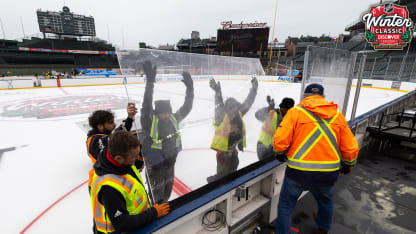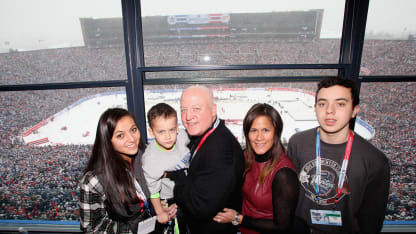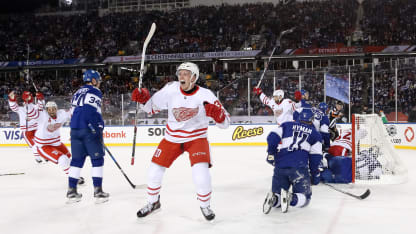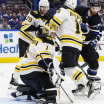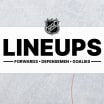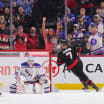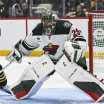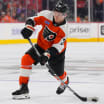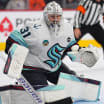NHL.com staff writer Mike Zeisberger has been covering the NHL regularly since 1999. Each Monday he will use his extensive network of hockey contacts for his weekly notes column, "Zizing 'Em Up.”
TORONTO -- When the Chicago Blackhawks and St. Louis Blues step onto the ice at iconic Wrigley Field in Chicago on Tuesday (5 p.m. ET; MAX, truTV, TNT, SN, TVAS), it will mark the 42nd regular-season outdoor game staged by the NHL.
Bill Daly has been to every one of those except one.
The NHL Deputy Commissioner’s perfect attendance record at such events was spoiled when he missed the Edmonton Oilers’ 5-2 victory against the Calgary Flames at Commonwealth Stadium at the Heritage Classic in Edmonton on Oct. 29, 2023.
“It was my oldest daughter Taylor’s wedding,” Daly said. “I think that’s a legitimate excuse.”
Indeed, a more-than-acceptable reason for one of the few people who has witnessed almost every one of these outdoor spectacles firsthand.
As such, with the latest instalment of NHL outdoor hockey coming New Years Eve in the Windy City, who better than Daly to break down the history of these outdoor games, complete with issues such as bone-chilling cold in Edmonton (2003) to soggy slush in Buffalo (2008) to sun glare in Lake Tahoe (2021)?
First off, when the first of these games took place in what was the Heritage Classic between the Oilers and Montreal Canadiens in Edmonton on that frigid evening on Nov. 22. 2003, could you have ever imagined how the concept would explode over the next two decades?
“Well, I was there and yes, it was cold. The Oilers deserve a lot of credit for conceiving the idea. It was actually a pretty large investment for them at the time to pull off an outdoor game because there’s a lot that goes into these things. Obviously, it’s grown over time since we took it over and kind of ran with it. It’s an enormous undertaking, and I think it struck a chord with our fans. It creates a different type of arena experience. I don’t want to use the football analogy, but it’s socializing. It’s kind of a social event, as opposed to a pure game. The benefit is that you have a game that means something being contested on the ice, sometimes in bad weather, sometimes in bad conditions, but the same for both teams. It’s been successful.”
What were some of the growing pains the League had to learn about during that 2003 Heritage game, or the first Winter Classic in Buffalo on Jan. 1, 2008?
“It’s interesting, because I would consider both of those first two games very precarious in the sense that, yes, we were able to pull them off, but they weren’t perfect conditions. I mean, it was freezing in Edmonton, and I would imagine, other than the festive atmosphere, the fans probably weren’t all that comfortable for the duration of the game. And then, in Buffalo, we were a degree or two from not being able to play in that game because the snow/slush/rain could have killed the ice. It was very, very wet snow. We had a whole bunch of stoppages to fix ice issues because we didn’t have the framework rink that we have now. We actually have rinks now that we can add refrigeration systems and bring from event to event. We didn’t have it there, so we kind of built it from scratch. So, both of those events we came close not being able to successfully execute. The fact that we were able to pull them off really laid the groundwork and expansion in terms of being able to roll these out and execute them.”
How much smoother have things become over the years from the lessons gleaned from those early events?
"Well, as you’d suspect, we’ve done it so many times now that I will say it’s become a standardized exercise. At the same time, each building presents its own challenges, its own differences. But certainly, I think we’ve identified, collectively and internally, all the issues that need to be thought out, the issues that need to be worked through. Some things like weather we can’t necessarily solve. We’ve been fortunate we’ve never had to cancel one of these games. We’ve never had to postpone one of these games from one day to another, which is pretty remarkable when you think about it, knock on wood. We understand that. We actually postponed one of these in Pittsburgh (2011) from a day game to a night game to avoid a predicted rain window. It didn’t work out that way despite our talking with some of the best meteorologists, but we still got the game in. I find it remarkable we haven’t had to move a game based on weather conditions.”
What are some of the top lasting memories from these games, especially when you consider games have been played at iconic venues like Fenway Park, Wrigley Field, Notre Dame Stadium, Dodger Stadium, Michigan Stadium and, coming up in February, Ohio Stadium, just to name a few?
“I mean, you mentioned the ones that come to my mind right away, right? There’s the back-to-back ones in 2017 where we had the Centennial Classic on Jan. 1 between Detroit and the [Maple] Leafs in Toronto, then packed up our entire crew, got on a charter and went to St. Louis the next day for the Winter Classic on Jan. 2 between the Blues and Blackhawks. And Dodger Stadium (2014). Remarkable, right? At puck drop, it was probably high 60s Fahrenheit, and, by the end, it was low 50s. And the ice held up. Our ice staff did an amazing job kind of protecting and shielding the ice from the sun. The game at Notre Dame Stadium was pretty cool, the ‘Big House’ in Ann Arbor, the Toronto game. … What’s cool is seeing some of these venues from the inside and how they operate. That’s special. And the Lake Tahoe game, there were no fans because of (COVID concerns), but it was a remarkable scene. Because of sun concerns we had to move the one game after the first period to the night time. And then the sunset game between Boston and Philadelphia the next day, just remarkable. Those are the kind of memories and portraits in your head in terms of some of the things we’ve seen.”
